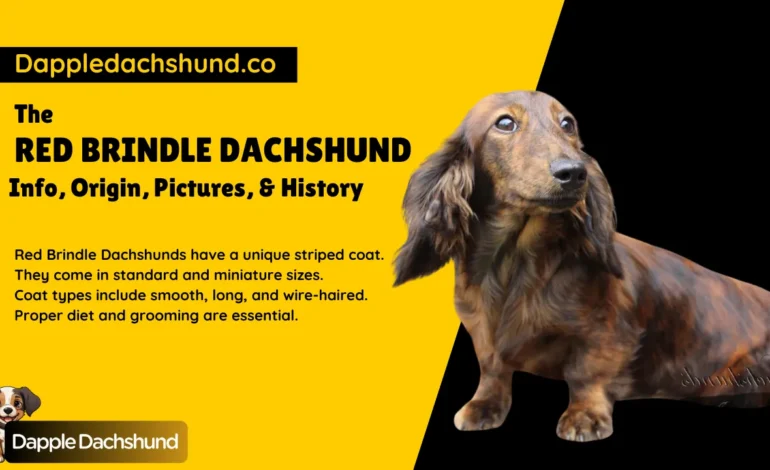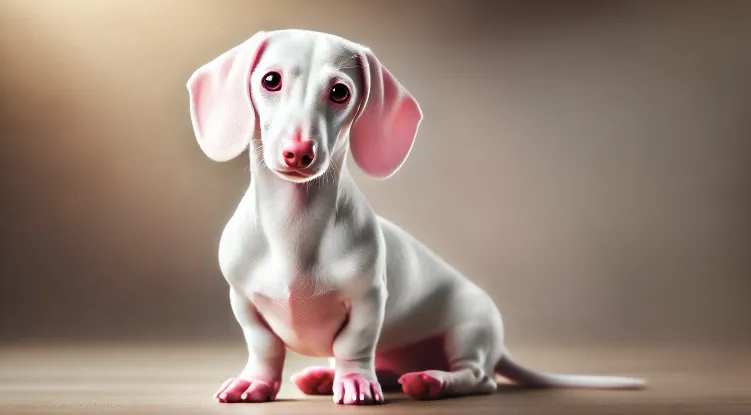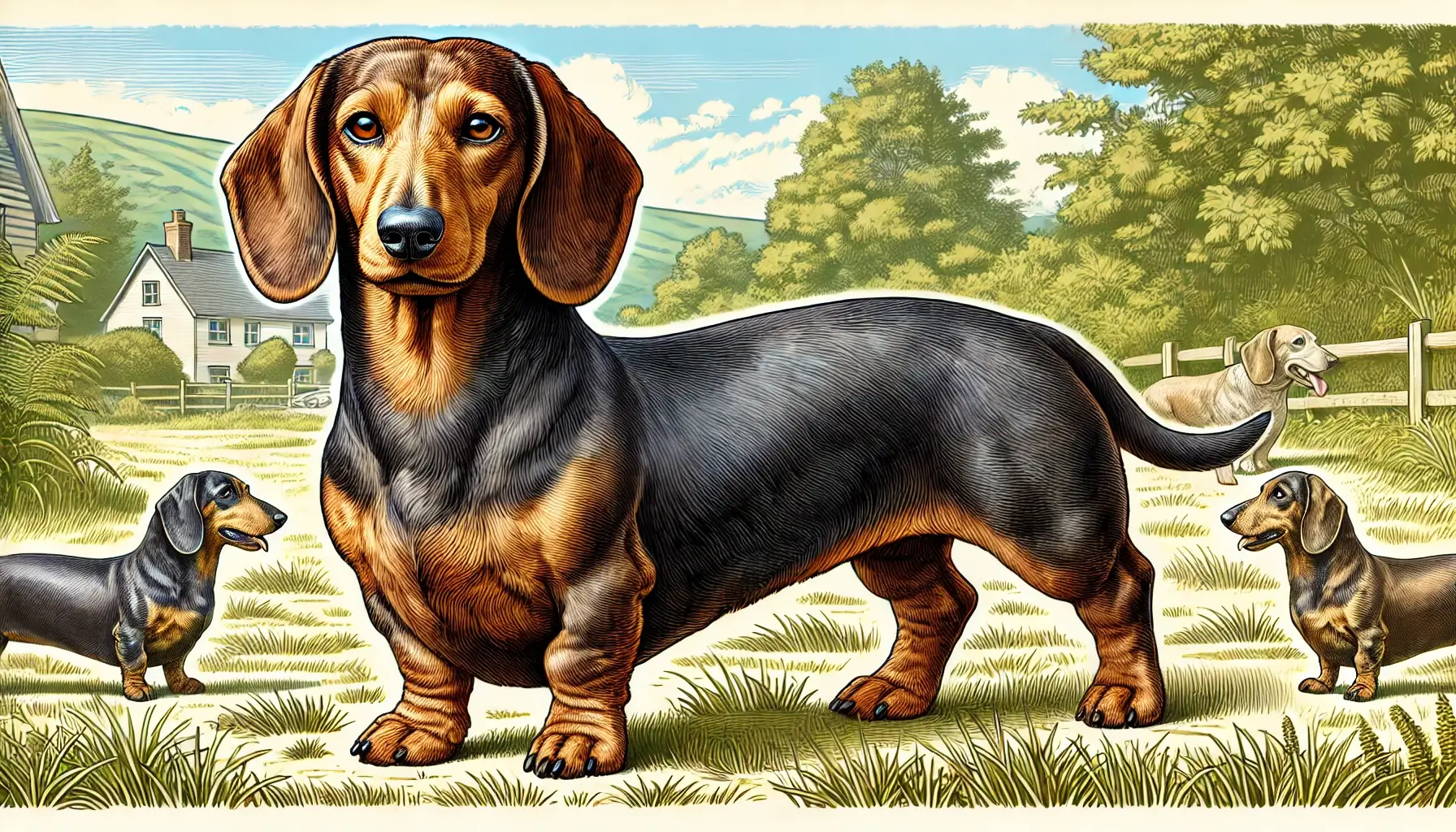
Miniature Dachshund Breeding Color Chart (The 15 Doxie Color with Pictures)
Have you ever wondered how many different colors Miniature Dachshunds can have? Let’s see if you can guess! If you can’t, let me leave it here, and I will answer this at the end of the blog post.
Historically, Miniature Dachshunds come in a variety of colors, but did you know that behind each color lies a complex genetic code that determines the unique coat your pup will sport?
There is the classic black and tan, then, a black and chocolate dachshund which makes it so adorable and appealing to Doxie owners, and it ends with an exotic dapple and piebald. The color variations are not just beautiful but also fascinating when you dig into the breeding patterns and genetic influences.
This article is where we’re going to break down each color variation, explain the genetics behind them, and provide you with a dachshund breeding chart to help you understand what to expect in your next doxin. Let’s get started without wasting any time.
How Does a Dachshund Get its Coat Color?
How does a Dachshund get its coat color? The answer is always genetics, which has provided us with a deep understanding of genetic factors that influence everything from basic coat shades to unique patterns like dapple and brindle.
Four genes play a key role in determining a Dachshund’s coat color, which are:
- Agouti (A) gene: Controls the distribution of black pigment, leading to different base coat colors.
- Eumelanin (B and D loci): Influences black and brown pigments.
- Merle (M) gene: Responsible for the dapple pattern, creating lighter spots over the coat.
- Recessive red (ee gene): Dilutes other colors to produce a cream or red coat.
Dominant vs Recessive Genes
The genes exist in an alternate pair on chromosomes which we refer to as Alleles, which are represented by Capital or Small letters.
The Capital letter means the Allele is Dominant and will have an effect on color, while the small letter means it’s recessive and won’t contribute to the Dachshund’s coat color.
The Primary Colors of Dachshund’s Coat
While Dachshunds come in a variety of shades, the core coat colors are Red, Cream, Black and Tan, Black and Cream, Chocolate and Tan, and Chocolate and Cream.
These primary colors serve as the building blocks for other color variations and patterns. The combination of dominant and recessive genes within a Dachshund’s DNA determines which of these base colors will appear in their coat.
AKC-Recognized Dachshund Colors
The American Kennel Club (AKC)-recognizes various colors, and registers them under specific color codes. These are as follows:
| Description | Registration Code | Color Description | Breed Standard Color |
| Blue & Cream | 273 | A diluted black coat, often with creamy markings. | ✔ |
| Wheaten | 224 | A light blonde or wheat color, commonly seen in wire-haired Dachshunds. | ✔ |
| Black & Cream | 010 | Black coat with cream markings, including under the eyes and legs. | ✔ |
| Fawn (Isabella) & Tan | 317 | Diluted chocolate with pale tan markings. | ✔ |
| Chocolate & Tan | 072 | A rich chocolate base with tan points. | ✔ |
| Wild Boar | 226 | A mix of black, brown, and gray hairs resembling a wild boar. | ✔ |
| Fawn | 082 | Diluted chocolate color, known as fawn, with a soft appearance. | ❌ |
| Red | 140 | Solid red, ranging from deep mahogany to golden tones. | ✔ |
| Cream | 076 | A pale, light coat with no darker shading, typically soft cream. | ✔ |
| Chocolate | 071 | Solid chocolate-brown coat without any additional markings. | ❌ |
| Black | 007 | A deep, solid black coat with no other markings. | ❌ |
| Fawn (Isabella) & Cream | 524 | Diluted chocolate with cream markings, often a soft contrast. | ✔ |
| Blue & Tan | 044 | Steel-blue coat with tan points, similar to black and tan. | ✔ |
| Chocolate & Cream | 526 | Deep chocolate coat with creamy points, often on the chest and legs. | ✔ |
| Black & Tan | 018 | Black base with tan markings on the face, chest, and legs. | ✔ |
Dachshund Breeding Color Chart: What Colored Dachshunds Are Safe to Breed?
For ethical breeding practices, it’s important to prioritize the health and well-being of the puppies over aesthetic color preferences. Some Dachshund color combinations, especially those involving the dapple (merle) gene, can lead to serious health problems like deafness and blindness, particularly when two dapple dogs are bred together, resulting in double dapples. To avoid such risks, responsible breeders should only pair Dachshunds with compatible genetic backgrounds that minimize the chances of health issues. Breeding color-safe Dachshunds with stable genetics helps ensure that future generations of these adorable dogs are born healthy, vibrant, and free from genetic disorders.
When choosing breeding pairs, it’s also essential to conduct genetic testing to ensure no recessive or harmful genes are passed on unknowingly. The primary goal is to maintain the breed’s integrity while preventing any health complications.
Two Most Common Colors in Smooth and Longhaired Dachshunds
The two most common coat colors in Smooth and Longhaired Dachshunds are red and black & tan. These colors are seen in a large number of the breed due to their genetic dominance.
- Red Dachshunds often appear in various shades, from light golden to deep chestnut. This color is homozygous (RR) in some dogs, meaning they can only pass the red gene to their offspring.
- Black & Tan Dachshunds are heterozygous (Rb), carrying both the black and tan and red genes, depending on their genetic makeup.
Color Genetics Overview: Red vs. Black & Tan
Here’s a simplified look at the base colors of red and black & tan in Dachshunds:
- Red Homozygous (RR): These Dachshunds can only produce red puppies when bred. They pass on two dominant red genes (RR), ensuring their offspring will always be red.
- Red Carries Black & Tan (Rb): These Dachshunds carry both the red gene and a recessive black & tan gene. When bred, their offspring can be either red or black & tan, depending on the pairing.
- Black & Tan (bb): These Dachshunds will always carry the black & tan gene and, depending on the other parent’s genetics, can produce a variety of color combinations.
Color Possibilities Based on Breeding Combinations
| Parent Combination | Offspring Possibilities |
| Red (Homozygous RR) + Red (Homozygous RR) | 100% Red (RR) |
| Red (Homozygous RR) + Red (Carries B&T Rb) | 100% Red (RR or Rb) |
| Red (Homozygous RR) + Black & Tan (bb) | 100% Red (Rb) |
| Red (Carries B&T Rb) + Red (Carries B&T Rb) | Red or Black & Tan (RR, Rb, or bb) |
| Red (Carries B&T Rb) + Black & Tan (bb) | Red or Black & Tan (Rb or bb) |
| Black & Tan (bb) + Black & Tan (bb) | 100% Black & Tan (bb) |
As shown in this chart, a Red Dachshund that is homozygous (RR) will always produce red puppies, even when bred with a Black & Tan Dachshund. However, if the Red Dachshund carries the recessive Black & Tan gene (Rb), there’s a possibility of producing either Red or Black & Tan offspring.
This knowledge is essential for breeders to ensure they produce healthy puppies with the desired coat colors while maintaining genetic diversity within the breed.
The 15 Doxies in a Miniature Dachshund Breeding Color Chart
Miniature Dachshunds come in a wide range of colors, and each color is a result of different genetic combinations.
Understanding the genetic makeup of each color is crucial for breeders to ensure they produce healthy, ethically bred Dachshunds with the desired coat colors.
Below is a detailed explanation of the 15 colors along with the genetics responsible for each one, followed by a breeding chart for each.
1. Black & Tan
- Gene Responsible: The black & tan color is controlled by the A (Agouti) locus, which regulates the distribution of eumelanin (black pigment) and pheomelanin (tan).
| Breeding Chart | Offspring Possibilities |
| Black & Tan (Bb) + Black & Tan (Bb) | Black & Tan puppies (100%) |
| Black & Tan (Bb) + Red (Rb) | Black & Tan or Red puppies |
2. Chocolate & Tan
- Gene Responsible: The chocolate color comes from the B locus (brown gene), which results in a brown coat instead of black. It is a recessive gene, so both parents must carry it for chocolate puppies to appear.
| Breeding Chart | Offspring Possibilities |
| Chocolate & Tan (bb) + Chocolate & Tan (bb) | Chocolate & Tan (100%) |
| Chocolate & Tan (bb) + Black & Tan (Bb) | Black & Tan or Chocolate & Tan |
3. Cream
- Gene Responsible: Cream is controlled by the E locus. The ee gene prevents eumelanin (black pigment) from being produced, resulting in a cream coat.
| Breeding Chart | Offspring Possibilities |
| Cream (ee) + Cream (ee) | Cream (100%) |
| Cream (ee) + Red (Rb) | Cream or Red puppies |
4. Wheaten
- Gene Responsible: The wheaten color results from a recessive gene at the C locus, which dilutes the base coat color to a lighter, wheaten shade.
| Breeding Chart | Offspring Possibilities |
| Wheaten (cc) + Wheaten (cc) | Wheaten puppies (100%) |
| Wheaten (cc) + Red (Rb) | Red or Wheaten puppies |
5. Wild Boar
- Gene Responsible: Wild boar is a mix of black, brown, and gray hairs, and is influenced by the A locus for agouti pattern. It’s commonly seen in wire-haired Dachshunds.
| Breeding Chart | Offspring Possibilities |
| Wild Boar (Aa) + Wild Boar (Aa) | Wild Boar (100%) |
| Wild Boar (Aa) + Black & Tan (Bb) | Wild Boar or Black & Tan |
6. Red
- Gene Responsible: Red is the dominant color and is influenced by the E locus. Red Dachshunds can be homozygous (RR) or heterozygous (Rb) depending on their genetic makeup.
| Breeding Chart | Offspring Possibilities |
| Red Homozygous (RR) + Red Homozygous (RR) | Red (100%) |
| Red Carries B&T (Rb) + Red Carries B&T (Rb) | Red or Black & Tan (Rb, bb) |
7. Blue & Tan
- Gene Responsible: The D (dilution) locus is responsible for diluting black pigment to blue. When combined with the tan points, it results in a blue & tan coat.
| Breeding Chart | Offspring Possibilities |
| Blue & Tan (dd) + Blue & Tan (dd) | Blue & Tan (100%) |
| Blue & Tan (dd) + Black & Tan (Bb) | Blue & Tan or Black & Tan |
8. Fawn (Isabella) & Tan
- Gene Responsible: Fawn (Isabella) is also controlled by the D locus, but in this case, it dilutes chocolate to a lighter, fawn color.
| Breeding Chart | Offspring Possibilities |
| Fawn & Tan (dd) + Fawn & Tan (dd) | Fawn & Tan (100%) |
| Fawn & Tan (dd) + Chocolate & Tan (bb) | Fawn & Tan or Chocolate & Tan |
9. Black & Cream
- Gene Responsible: Black & cream Dachshunds have the same A locus gene for black & tan but with cream replacing the tan points due to the E locus.
| Breeding Chart | Offspring Possibilities |
| Black & Cream (Bb) + Black & Cream (Bb) | Black & Cream (100%) |
| Black & Cream (Bb) + Red (Rb) | Black & Cream or Red |
10. Black
- Gene Responsible: Solid black coats result from dominant black genes at the A locus without any tan or cream points.
| Breeding Chart | Offspring Possibilities |
| Black (BB) + Black (BB) | Black (100%) |
| Black (BB) + Black & Tan (Bb) | Black or Black & Tan |
11. Chocolate
- Gene Responsible: Solid chocolate comes from a recessive gene at the B locus. Both parents must carry the chocolate gene for solid chocolate Dachshunds to appear.
| Breeding Chart | Offspring Possibilities |
| Chocolate (bb) + Chocolate (bb) | Chocolate (100%) |
| Chocolate (bb) + Black & Tan (Bb) | Chocolate or Black & Tan |
12. Fawn (Isabella) & Cream
- Gene Responsible: Fawn combined with cream points results from both the D and E loci, which dilute the base coat and modify the points to cream.
| Breeding Chart | Offspring Possibilities |
| Fawn & Cream (dd) + Fawn & Cream (dd) | Fawn & Cream (100%) |
| Fawn & Cream (dd) + Cream (ee) | Fawn & Cream or Cream |
13. Chocolate & Cream
- Gene Responsible: Chocolate & cream is similar to chocolate & tan, except the points are modified by the E locus to create cream markings.
| Breeding Chart | Offspring Possibilities |
| Chocolate & Cream (bb) + Chocolate & Cream (bb) | Chocolate & Cream (100%) |
| Chocolate & Cream (bb) + Black & Tan (Bb) | Chocolate & Cream or Black & Tan |
14. Blue & Cream
- Gene Responsible: Blue & cream results from the D locus diluting black to blue and the E locus changing the tan points to cream.
| Breeding Chart | Offspring Possibilities |
| Blue & Cream (dd) + Blue & Cream (dd) | Blue & Cream (100%) |
| Blue & Cream (dd) + Black & Tan (Bb) | Blue & Cream or Blakc & Tan |
15. Fawn
- Gene Responsible: Solid fawn is a result of the dilution gene acting on the chocolate coat, controlled by the D locus.
| Breeding Chart | Offspring Possibilities |
| Fawn (dd) + Fawn (dd) | Fawn (100%) |
| Fawn (dd) + Chocolate (bb) | Fawn or Chocolate |
Frequently Asked Questions (FAQs)
What Color Dachshunds Can You Breed Together?
You can breed any color Dachshunds together as long as they don’t carry harmful genes that could cause health issues, such as breeding two dapple Dachshunds, which may lead to a double dapple with serious health risks.
What Color Puppies Will My Dachshund Have?
The color of your Dachshund puppies depends on the genetics of both parents. Dominant genes like red or black & tan often appear more frequently, while recessive genes like chocolate or blue may only show if both parents carry those genes.
What Is The Rarest Color For A Miniature Dachshund?
The rarest colors for Miniature Dachshunds are solid black, solid chocolate, and all-white, which occur due to specific recessive genes.
What Colors Do Miniature Dachshunds Come In?
Miniature Dachshunds come in a variety of colors, including black & tan, red, chocolate & tan, cream, blue, Isabella (fawn), and more, with several patterns like dapple, piebald, and brindle also available.
Conclusion: Miniature Dachshund Breeding Color Chart
The Miniature Dachshund Breeding Color Chart offers a fascinating look at how genetics shape the wide variety of coat colors within the breed, from black and tan to more exotic shades like blue and cream.
While it’s essential to understand the science behind these colors, responsible breeding practices should always take precedence.
After all, choosing the right breeding pairs is about more than just aesthetics—it’s about ensuring that each generation of Dachshunds remains healthy, vibrant, and true to the breed’s characteristics.
Color might be what draws the eye initially, but temperament and health are what truly make a Dachshund a beloved companion.
By focusing on ethical breeding, not only do you maintain the physical beauty of the breed, but you also nurture the traits that make Dachshunds such loyal and loving pets. After all, their charming personalities are what truly make them shine, no matter what color they come in!





